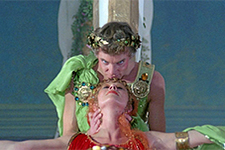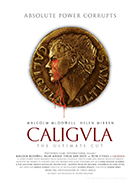Caligula: The Ultimate Cut
|  There are a variety of memes that always make the rounds on social media during daylight savings time that mock the idea of setting our clocks backward or forward. One of the most popular includes an image of a Native American chief who says something to the effect of “Only the white man is dumb enough to think you can cut a foot off the end of a blanket, sew it to the other end of the blanket, and have a longer blanket.” Where this supposed bit of indigenous wisdom came from remains one of the Internet’s great mysteries (I doubt it was actually uttered by a Native American chief), but I couldn’t help but think of it as I watched Caligula: The Ultimate Cut, which purports to be a completely refashioned (and much improved) version of Caligula, the infamous 1979 orgiastic art-porn epic funded by Penthouse publisher Bob Guccione. Like the inanity of trying to lengthen a blanket by moving one end to the other, reworking Caligula into something demonstrably better is an exercise in futility because, despite being composed entirely of “never before seen” footage, meaning that all the shots are alternate takes not used in previous versions of the film, it is still footage shot by the same director … and the same cinematographer … on the same sets … with the same actors. In other words, if the original Caligula was cut together from mostly garbage, why would a version assembled from slightly different versions of the same garbage be so much better? The answer is: It isn’t. If Caligula: The Ultimate Cut, which now clocks in at 178 minutes, is any better than the 156-minute original, it is only because one couldn’t make the film much worse than it already was. All of the work that went into assembling this new version by producer Thomas Negovan, an art historian, photographer, and musician, does little more than demonstrate just how flawed the project was from the outset and how incompetently much of it was shot despite having a massive, Hollywood-level budget and the involvement of an impressive array of artisans and a roster of talented actors in front of the camera (whose later protestations that they had “no idea” they were appearing in a big-budget porn film seem pretty disingenuous given the number of exposed genitals with which they constantly shared the screen). Although it is somewhat hard to imagine now, there was a period in the early 1970s when hard-core pornographic features were threatening to become a regular part of the mainstream film industry. At that time, hard-core features were being reviewed in industry trade magazines, were appearing regularly on Variety’s weekly top 50 box-office list, and were often playing in theaters right next to “legitimate” Hollywood films. The fascination with what became known as “porno chic” briefly infiltrated the mainstream movie industry, resulting in sexually explicit (though not hard core) art house hits like Last Tango in Paris (1972) and Emmanuelle (1974). It is within this context that Penthouse publisher Bob Guccione, who had invested in films before, most notably Roman Polanski’s Chinatown (1974), decided to fund Caligula, which he envisioned as a “serious” Hollywood-style historical spectacle that also happened to be sexually explicit. The film actually began production in 1976, but due to legal wrangling over ownership that dragged the editing phase out over three years, Caligula did not make its theatrical debut in the United States until February of 1980, where it was immediately best with all manner of legal challenges. The final cost of the film was reportedly $17.5 million (roughly $80 million today) at a time when the average Hollywood studio film cost about $9 million. To ensure an air of seriousness, Guccione not only gave the film an enormous budget that allowed it to be shot at the famed Dear Studio in Rome on massive, full-scale sets, he also made sure there were well-known names in front of and behind the camera. He was able to cast Malcolm McDowell, Peter O’Toole, John Gielgud, and Helen Mirren, which gave the film a veneer of serious artistic intent. Novelist, historian, and screenwriter Gore Vidal, who had originated the project with his screenplay, was so deeply associated with the film that it was originally to be titled Gore Vidal’s Caligula. The producer who brought Vidal’s original screenplay to Guccione’s attention was Franco Rossellini, nephew of famed neorealist director Roberto Rossellini and producer of several of Pier Paolo Pasolini’s later films, including Teorema (1968) and Il Decamerone (1971). The sets and costumes were designed by Danilo Donati, who had worked with Federico Fellini on Fellini Satyricon (1969) and Amarcord (1974), as well as for Franco Zefferelli and Pasolini. But then Guccione went and hired director Tinto Brass, who had started in the 1960s as an art and experimental director, but was then best known for his most recent film Salon Kitty (1976), a stylish if sleazy film about a brothel in Nazi Germany. From the very beginning the production was rife with problems. Early on there were clashes among Vidal, Guccione, and Brass. Vidal charged that his script was being rewritten, and Guccione was incensed with Brass’s direction, claiming that the director was purposefully making the film antierotic, which would not appeal to the Penthouse fan base. Guccione solved that problem by slipping onto the sets with a skeleton crew after hours to shoot his own hard-core footage that was then cut into the film after Brass was fired during postproduction. Brass’s final screen credit read “Principal Photography by Tinto Brass,” meaning that Caligula is a rare modern film that does not officially credit a director. While all this was going on, Vidal began to have second thoughts about his involvement in the production and sued to get his name removed as screenwriter (his final credit reads “Adapted From an Original Screenplay by Gore Vidal”). The resulting film was, by any stretch of the imagination, a massive failure, and trying to reimagine it into something otherwise by assembling a new version from alternate takes only reinforces the film’s fundamentally flawed nature. Part of the problem rests in the conflict between Vidal and Brass’s take on the title character, Gaius Caligula, the fourth Roman Emperor. While Vidal saw him as a decent man who was corrupted by the absolute power that was bestowed upon him (thus keeping the film in line with so many of his historical novels and political outlook), Brass saw Caligula as a monster from the get-go. Some critics night lead you to believe that the “Ultimate Cut” brings the film closer to Vidal’s intended character arc, but it doesn’t. McDowell’s Caligula is still a leering, perverse sadist from the opening reel and only gets worse. The very first scene finds him in bed with his sister, Drusilla (Teresa Ann Savoy), and when he assumes power from the dying, ravaged emperor Tiberius (Peter O’Toole), he literally wrenches the ring off his finger with a maniacal grin. No matter how many different takes are used, McDowell’s performance is still a wide-eyed, cartoonish embarrassment that purports to be an honest-ugly depiction of the logical extremes of power in the thralls of excess, but it is just grotesque. There is no humanity in McDowell’s characterization, and no arc can be dug out of the wreckage of footage that Brass shot. It is still clear that Caligula was a film of great expense—the massive sets and elaborate costumes are testament to the massive amounts of money that were spent, even though Brass clearly had little idea what to do with it all. Much of the film is set up in tableaux like a silent film from 1910, except that Brass’s camera frequently wanders from its perch as if it is in search of something more interesting than what is laid out before it. Brass is mostly content to simply mix sex and violence in as many extreme ways as he can muster. The graphic nature of the violence remains in this new version, including a scene where a guard is forced to drink copious amounts of wine and then has his gut slashed open. The fact that this takes place amidst a Fellinesque circus of group sex and physically deformed background characters is a good example of the film’s uneasy melding of the violent and the erotic, with the former being dominant every time. Although the graphic violence is largely separated from the film’s representations of sexuality, one could argue that most of the sex in the film is tinged with violence, as virtually none of it is depicted in terms of consenting lovers (the only exception is the incestuous love between Caligula and Drusilla, which says a lot). Rather, the sexuality in Caligula is that of underlings trapped in a power dynamic that forces them to display themselves for the bemusement of those above them, which unconsciously reflects what many critics argue is the basic relationship in pornography between model and spectator. This is never so clear as in the massive orgy sequence in which Caligula turns all the senators’ wives into prostitutes at an “imperial brothel.” Yet, all the writhing naked flesh becomes quickly tiresome, and any critique of phallic power dynamics is lost in the film’s visual excess and its inability to link its depictions of sex and violence to anything beyond their own shock value. Whether or not this is the “Ultimate Cut” of Caligula is left for the viewer to decide, but let us hope that it is the last. Copyright © 2024 James Kendrick Thoughts? E-mail James Kendrick All images copyright © Drafthouse Films |
Overall Rating: 
 (1.5)
(1.5)


